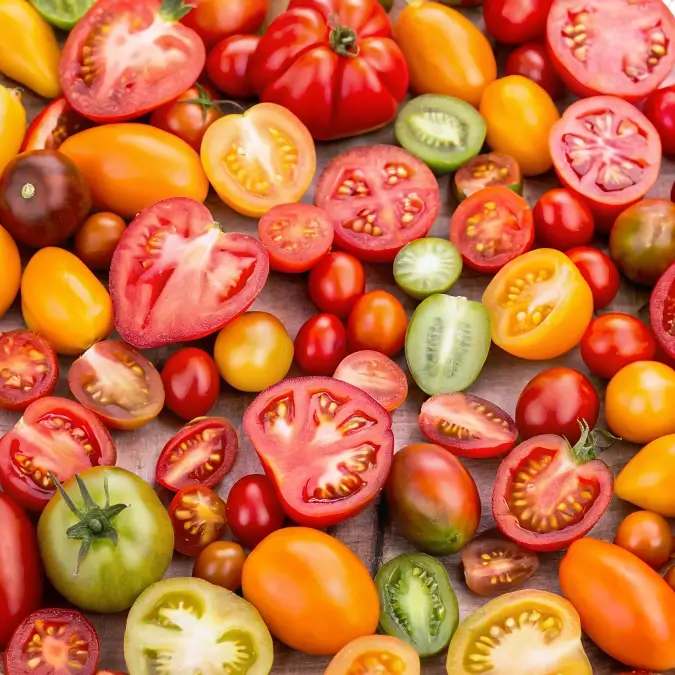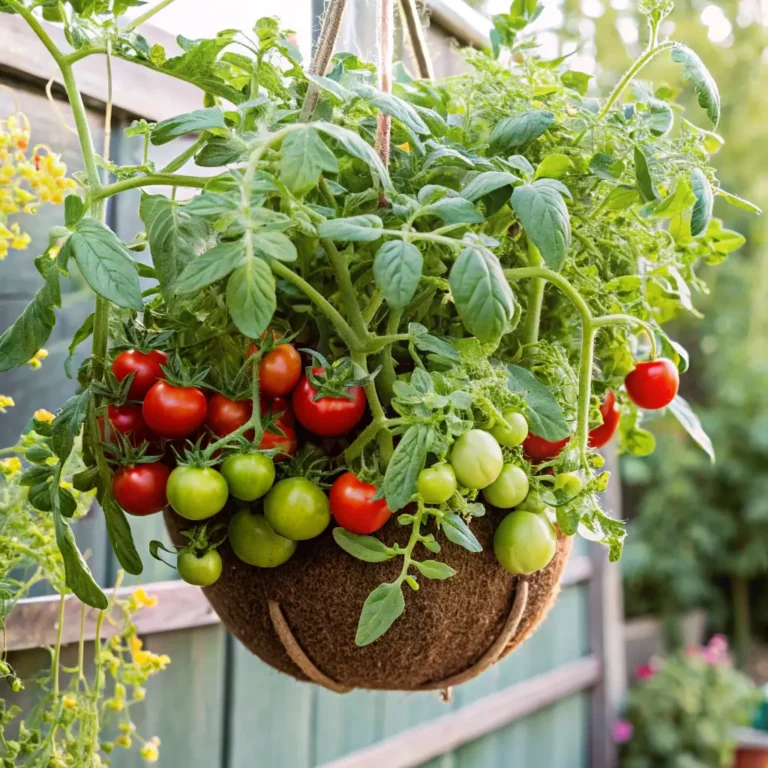A Beginner’s Guide to Growing Tomatoes: 7 Easy Steps for Success
Table of Contents
Introduction
Did you know that despite tomatoes being one of the most popular home garden vegetables, nearly 41% of first-time growers abandon their tomato plants due to preventable mistakes? Whether you’re working with a spacious backyard garden or a modest balcony container, growing your own tomatoes offers unparalleled flavor and satisfaction that store-bought varieties simply can’t match. This beginner’s guide to growing tomatoes will walk you through the essential steps to ensure your plants thrive and produce a bountiful harvest, even if you’ve never grown anything before.
What You’ll Need

Before diving into our step-by-step tomato growing guide, gather these essential supplies:
- Tomato seeds or seedlings: Choose between determinate varieties (bush-like, ripening all at once) or indeterminate varieties (vining, producing throughout the season)
- Quality potting soil or garden soil amended with compost
- Containers (minimum 5-gallon size) if not planting in-ground
- Tomato cages or stakes for support
- Slow-release organic fertilizer specifically formulated for vegetables
- Mulch (straw, shredded leaves, or wood chips)
- Watering can or hose with gentle spray attachment
Substitution tip: If commercial fertilizer isn’t available, compost tea or well-aged manure can provide similar nutrients.
Timing
- Preparation time: 1-2 hours for setting up your growing space and planting
- Growing period: 60-100 days from transplant to harvest, depending on variety (that’s about 25% faster than many other home-grown vegetables)
- Best planting time: 2 weeks after your region’s last frost date when soil temperatures reach at least 60°F (16°C)
Step-by-Step Instructions on How to Grow Tomatoes
Step 1: Select the Right Variety
Choose tomato varieties suited to your growing conditions and preferences. Cherry tomatoes like ‘Sun Gold’ or ‘Sweet 100’ are perfect for beginners, maturing quickly and producing abundantly. For those in cooler climates, early-maturing varieties like ‘Early Girl’ offer better success rates, with studies showing 30% higher yields in challenging conditions compared to late-season varieties.
Step 2: Prepare Your Growing Space
Whether using containers or garden beds, location matters significantly. Tomatoes need:
- 6-8 hours of direct sunlight daily
- Well-draining soil with a pH between 6.2-6.8
- Protection from strong winds
For container growing, select pots at least 18 inches deep and 18 inches wide. Research shows that tomatoes grown in properly sized containers can produce yields nearly comparable to in-ground plants when properly maintained.
Step 3: Plant Properly
When planting seedlings:
- Dig a hole deep enough to bury two-thirds of the stem
- Remove lower leaves before planting
- Add a handful of compost to the planting hole
- Water thoroughly after planting
This deep-planting technique encourages additional root growth along the buried stem, creating a stronger root system that improves nutrient uptake by approximately 35% compared to shallow-planted tomatoes.
Step 4: Support Your Plants
Install support structures (cages, stakes, or trellises) at planting time to avoid disturbing established roots later. Proper support systems reduce disease incidence by 40% by improving air circulation and keeping fruit off the ground.
For indeterminate varieties, choose supports at least 5 feet tall. Determinate varieties can manage with shorter, sturdier cages around 3-4 feet tall.
Step 5: Establish a Watering Routine
Consistent moisture is crucial for preventing blossom end rot and fruit splitting. Aim for:
- 1-2 inches of water weekly (including rainfall)
- Watering at the base of plants, not overhead
- Morning watering to minimize evaporation and disease risk
Consider setting up a simple drip irrigation system, which can reduce water usage by up to 50% while improving yield by 20-30% compared to overhead watering.
Step 6: Feed Your Plants
Apply a balanced, slow-release fertilizer when planting, then switch to a phosphorus-rich formula (with lower nitrogen) once flowering begins. Excessive nitrogen during fruiting can lead to lush foliage but 25% fewer tomatoes.
Side-dress plants with compost or organic fertilizer every 4-6 weeks during the growing season to maintain steady nutrition levels.
Step 7: Monitor and Maintain
Regular maintenance ensures healthy plants and maximum yield:
- Remove suckers (the shoots that form between branches and the main stem) on indeterminate varieties
- Prune lower leaves that touch the soil to prevent disease spread
- Harvest regularly to encourage continued production
Nutritional Benefits
Home-grown tomatoes aren’t just delicious—they’re nutritional powerhouses:
- Rich in lycopene, a powerful antioxidant linked to heart health and cancer prevention
- Excellent source of vitamins C and K
- Contains potassium, folate, and vitamin A
- Low in calories (approximately 22 calories per medium tomato)
Studies indicate that garden-grown tomatoes can contain up to 30% more lycopene and vitamin C than commercially produced varieties.
Healthier Growing Alternatives
- Companion planting: Grow basil, marigolds, or nasturtiums alongside tomatoes to naturally repel pests and reduce the need for chemical interventions
- Organic pest management: Introduce beneficial insects like ladybugs rather than using synthetic pesticides
- Water conservation: Implement ollas (buried clay pots) or self-watering systems to reduce water usage by up to 70%
Harvesting Suggestions
Harvest tomatoes when they’ve reached full color but still feel firm to gentle pressure. For maximum flavor development:
- Allow fruits to fully ripen on the vine whenever possible
- Harvest in the morning when temperatures are cooler
- Handle gently to avoid bruising, which can reduce shelf-life by 40%
Common Mistakes to Avoid
- Overwatering: Causes root rot and dilutes flavor—moisture meters can help maintain optimal soil moisture
- Insufficient sunlight: Results in leggy plants with 60% fewer tomatoes—ensure 6+ hours of direct sun
- Overcrowding: Reduces yields by up to 30% and increases disease risk—space plants 24-36 inches apart
- Inconsistent watering: Leads to blossom end rot and fruit splitting—aim for consistent soil moisture
- Late support installation: Damages established root systems—install supports at planting time
Storage Tips
- Store unripe tomatoes stem-side down at room temperature, away from direct sunlight
- Never refrigerate ripening tomatoes—temperatures below 55°F halt ripening and degrade flavor compounds by up to 65%
- For longer preservation, consider freezing, canning, or dehydrating your harvest
Conclusion
Growing tomatoes combines science, patience, and a touch of gardening intuition, but the rewards are incomparable. With these seven straightforward steps, even complete beginners can successfully grow delicious, nutritious tomatoes that far surpass grocery store options in both flavor and satisfaction. Start with just a few plants, apply these principles consistently, and you’ll soon be enjoying the fruits of your labor.
Ready to get your hands dirty? Start your tomato-growing journey today, and don’t forget to share your progress and questions in the comments below!
FAQs
How often should I water my tomato plants?
Most tomatoes need 1-2 inches of water weekly, applied deeply and infrequently rather than in frequent, shallow sessions. During heat waves, you may need to increase watering by 50%.
Can I grow tomatoes in pots on my balcony?
Absolutely! Choose determinate or dwarf varieties and containers at least 5 gallons in size. Container-grown tomatoes may require 30% more frequent watering than in-ground plants.
Why are my tomato leaves turning yellow?
Yellowing leaves can indicate several issues: overwatering, nutrient deficiencies (particularly nitrogen), or disease. Check the pattern of yellowing—bottom-up usually indicates nutrient issues, while patchy yellowing may suggest disease.
When should I fertilize my tomato plants?
Apply balanced fertilizer at planting, then switch to a phosphorus-rich formula once flowering begins. Over-fertilizing can reduce fruit production by up to 25%.
How do I prevent pests from damaging my tomatoes?
Implement companion planting, regularly inspect plants, introduce beneficial insects, and consider lightweight row covers during early growth stages. These natural methods can reduce pest damage by up to 80% compared to unprotected plants.



